Numerical Mesoscale Modelling of Microstructure Evolution during Selective Laser Melting
Abstract
1. Introduction
2. Modelling the Heat Transfer
2.1. Material Properties
2.2. Boundary Conditions
2.3. Modelling the Heat Source
2.4. Finite Element Mesh
2.5. Validation
3. Modelling the Microstructure Evolution
3.1. Grain Nucleation
3.2. Grain Growth
3.3. Mesh Dependency
3.4. Simulation Parameters
4. Coupled Models
5. Conclusions and Outlook
Author Contributions
Funding
Conflicts of Interest
Abbreviations
| SLM | Selective laser melting |
| FEM | Finite element method |
| FE | Finite element |
| CA | Cellular automata |
| CAFE | Coupled finite element-cellular automata approach |
References
- Raghavan, N.; Dehoff, R.; Pannala, S.; Simunovic, S.; Kirka, M.; Turner, J.; Carlson, N.; Babu, S.S. Numerical modeling of heat-transfer and the influence of process parameters on tailoring the grain morphology of IN718 in electron beam additive manufacturing. Acta Mater. 2016, 112, 303–314. [Google Scholar] [CrossRef]
- Bikas, H.; Stavropoulos, P.; Chryssolouris, G. Additive manufacturing methods and modeling approaches: A critical review. Int. J. Adv. Manuf. Technol. 2016, 83, 389–405. [Google Scholar] [CrossRef]
- Olakanmi, E.O.; Cochrane, R.; Dalgarno, K. A review on selective laser sintering/melting (SLS/SLM) of aluminium alloy powders: Processing, microstructure, and properties. Progr. Mater. Sci. 2015, 74, 401–477. [Google Scholar] [CrossRef]
- Chang, I.; Zhao, Y. Advances in Powder Metallurgy: Properties, Processing and Applications; Elsevier: Amsterdam, The Netherlands, 2013; pp. 1–604. [Google Scholar] [CrossRef]
- Cooper, P.W. 3D Printing: A Potential Game Changer for Aerospace and Defense. Gain. Altit. 2013, 7. [Google Scholar]
- Gu, D. Laser Additive Manufacturing of High-Performance Materials; Springer: Amsterdam, The Netherlands, 2015. [Google Scholar]
- Thompson, S.M.; Bian, L.; Shamsaei, N.; Yadollahi, A. An overview of Direct Laser Deposition for additive manufacturing; Part I: Transport phenomena, modeling and diagnostics. Addit. Manuf. 2015, 8, 36–62. [Google Scholar] [CrossRef]
- Agius, D.; Kourousis, K.I.; Wallbrink, C. A review of the as-built SLM Ti-6Al-4V mechanical properties towards achieving fatigue resistant designs. Metals 2018, 8, 75. [Google Scholar] [CrossRef]
- Song, B.; Zhao, X.; Li, S.; Han, C.; Wei, Q.; Wen, S.; Liu, J.; Shi, Y. Differences in microstructure and properties between selective laser melting and traditional manufacturing for fabrication of metal parts: A review. Front. Mech. Eng. 2015, 10, 111–125. [Google Scholar] [CrossRef]
- Francois, M.M.; Sun, A.; King, W.E.; Henson, N.J.; Tourret, D.; Bronkhorst, C.A.; Carlson, N.N.; Newman, C.K.; Haut, T.; Bakosi, J.; et al. Modeling of additive manufacturing processes for metals: Challenges and opportunities. Curr. Opin. Solid State Mater. Sci. 2017, 21, 198–206. [Google Scholar] [CrossRef]
- Zinoviev, A.; Zinovieva, O.; Ploshikhin, V.; Romanova, V.; Balokhonov, R. Evolution of grain structure during laser additive manufacturing. Simulation by a cellular automata method. Mater. Des. 2016, 106, 321–329. [Google Scholar] [CrossRef]
- Rai, A.; Markl, M.; Körner, C. A coupled Cellular Automaton–Lattice Boltzmann model for grain structure simulation during additive manufacturing. Comput. Mater. Sci. 2016, 124, 37–48. [Google Scholar] [CrossRef]
- Zhang, X.; Yocom, C.J.; Mao, B.; Liao, Y. Microstructure evolution during selective laser melting of metallic materials: A review. J. Laser Appl. 2019, 31, 031201. [Google Scholar] [CrossRef]
- Karma, A.; Tourret, D. Atomistic to continuum modeling of solidification microstructures. Curr. Opin. Solid State Mater. Sci. 2016, 20, 25–36. [Google Scholar] [CrossRef]
- Dehoff, R.R.; Kirka, M.; Sames, W.J.; Bilheux, H.; Tremsin, A.S.; Lowe, L.E.; Babu, S.S. Site specific control of crystallographic grain orientation through electron beam additive manufacturing. Mater. Sci. Technol. 2015, 31, 931–938. [Google Scholar] [CrossRef]
- Boettinger, W.J.; Warren, J.A.; Beckermann, C.; Karma, A. Phase-field simulation of solidification. Ann. Rev. Mater. Sci. 2002, 32, 163–194. [Google Scholar] [CrossRef]
- Nie, P.; Ojo, O.A.; Li, Z. Numerical modeling of microstructure evolution during laser additive manufacturing of a nickel-based superalloy. Acta Mater. 2014, 77, 85–95. [Google Scholar] [CrossRef]
- Tourret, D.; Clarke, A.J.; Imhoff, S.D.; Gibbs, P.J.; Gibbs, J.W.; Karma, A. Three-Dimensional Multiscale Modeling of Dendritic Spacing Selection During Al-Si Directional Solidification. JOM 2015, 67, 1776–1785. [Google Scholar] [CrossRef]
- Trivedi, R.; Kurz, W. Theory of microstructural development during rapid solidification. In Science and Technology of the Undercooled Melt; Springer: Berlin, Germany, 1986; pp. 260–267. [Google Scholar]
- Tan, J.H.K.; Sing, S.L.; Yeong, W.Y. Microstructure modelling for metallic additive manufacturing: A review. Virt. Phys. Prototyp. 2020, 15, 87–105. [Google Scholar] [CrossRef]
- Cho, D.H. Determining the Temperature Field of Selective Laser Melting Process for Different Heat Source Paths. Ph.D. Thesis, Northeastern University, Boston, MA, USA, 2016. [Google Scholar]
- Dai, D.; Gu, D. Thermal behavior and densification mechanism during selective laser melting of copper matrix composites: Simulation and experiments. Mater. Des. 2014, 55, 482–491. [Google Scholar] [CrossRef]
- Minkowycz, W.J.; Sparrow, E.M.; Murthy, J.Y. Handbook of Numerical Heat Transfer, 2nd ed.; Wiley: Boca Raton, FL, USA, 2000. [Google Scholar]
- Gao, Y.; Xing, J.; Zhang, J.; Luo, N.; Zheng, H. Research on measurement method of selective laser sintering (SLS) transient temperature. Optik 2008, 119, 618–623. [Google Scholar] [CrossRef]
- Matsumoto, M.; Shiomi, M.; Osakada, K.; Abe, F. Finite element analysis of single layer forming on metallic powder bed in rapid prototyping by selective laser processing. Int. J. Mach. Tools Manuf. 2002, 42, 61–67. [Google Scholar] [CrossRef]
- Patil, R.B.; Yadava, V. Finite element analysis of temperature distribution in single metallic powder layer during metal laser sintering. Int. J. Mach. Tools Manuf. 2007, 47, 1069–1080. [Google Scholar] [CrossRef]
- Kolossov, S.; Boillat, E.; Glardon, R.; Fischer, P.; Locher, M. 3D FE simulation for temperature evolution in the selective laser sintering process. Int. J. Mach. Tools Manuf. 2004, 44, 117–123. [Google Scholar] [CrossRef]
- Carslaw, H.S.; Jaeger, J.C. Conduction of Heat in Solids; Clarendon Press: Oxford, UK, 1959. [Google Scholar]
- Ansari, M.J.; Nguyen, D.S.; Park, H.S. Investigation of SLM process in terms of temperature distribution and melting pool size: Modeling and experimental approaches. Materials 2019, 12, 1272. [Google Scholar] [CrossRef] [PubMed]
- Badrossamay, M.; Childs, T.H. Further studies in selective laser melting of stainless and tool steel powders. Int. J. Mach. Tools Manuf. 2007, 47, 779–784. [Google Scholar] [CrossRef]
- Foroozmehr, A.; Badrossamay, M.; Foroozmehr, E.; Golabi, S. Finite Element Simulation of Selective Laser Melting process considering Optical Penetration Depth of laser in powder bed. Mater. Des. 2016, 89, 255–263. [Google Scholar] [CrossRef]
- Hussein, A.; Hao, L.; Yan, C.; Everson, R. Finite element simulation of the temperature and stress fields in single layers built without-support in selective laser melting. Mater. Des. 2013, 52, 638–647. [Google Scholar] [CrossRef]
- Gandin, C.A. Modélisation de la solidification: Structures de grains et ségrégations des alliages métalliques. Comptes Rendus Phys. 2010, 11, 216–225. [Google Scholar] [CrossRef]
- Ma, L.; Bin, H. Temperature and stress analysis and simulation in fractal scanning-based laser sintering. Int. J. Adv. Manuf. Technol. 2007, 34, 898–903. [Google Scholar] [CrossRef]
- Dai, K.; Shaw, L. Thermal and mechanical finite element modeling of laser forming from metal and ceramic powders. Acta Mater. 2004, 52, 69–80. [Google Scholar] [CrossRef]
- Li, Y.; Gu, D. Thermal behavior during selective laser melting of commercially pure titanium powder: Numerical simulation and experimental study. Addit. Manuf. 2014, 1, 99–109. [Google Scholar] [CrossRef]
- Yang, J.; Yu, H.; Yang, H.; Li, F.; Wang, Z.; Zeng, X. Prediction of microstructure in selective laser melted Ti–6Al–4V alloy by cellular automaton. J. Alloys Compd. 2018, 748, 281–290. [Google Scholar] [CrossRef]
- Ilin, A.; Logvinov, R.; Kulikov, A.; Prihodovsky, A.; Xu, H.; Ploshikhin, V.; Günther, B.; Bechmann, F. Computer aided optimisation of the thermal management during laser beam melting process. Phys. Proc. 2014, 56, 390–399. [Google Scholar] [CrossRef]
- Fischer, P.; Romano, V.; Weber, H.P.; Karapatis, N.P.; Boillat, E.; Glardon, R. Sintering of commercially pure titanium powder with a Nd:YAG laser source. Acta Mater. 2003, 51, 1651–1662. [Google Scholar] [CrossRef]
- Goldak, J.A.; Akhlaghi, M. Computational Welding Mechanics; Springer Science & Business Media: Berlin, Germany, 2006. [Google Scholar]
- Shiomi, M.; Yoshidome, A.; Abe, F.; Osakada, K. Finite element analysis of melting and solidifying processes in laser rapid prototyping of metallic powders. Int. J. Mach. Tools Manuf. 1999, 39, 237–252. [Google Scholar] [CrossRef]
- Yu, G.; Masubuchi, K.; Maekawa, T.; Patrikalakis, N. FEM simulation of laser forming of metal plates. J. Manuf. Sci. Eng. 2001, 123, 405–410. [Google Scholar] [CrossRef]
- Khairallah, S.A.; Anderson, A. Mesoscopic simulation model of selective laser melting of stainless steel powder. J. Mater. Proc. Technol. 2014, 214, 2627–2636. [Google Scholar] [CrossRef]
- Lee, Y.; Zhang, W. Modeling of heat transfer, fluid flow and solidification microstructure of nickel-base superalloy fabricated by laser powder bed fusion. Addit. Manuf. 2016, 12, 178–188. [Google Scholar] [CrossRef]
- Qiu, C.; Panwisawas, C.; Ward, M.; Basoalto, H.C.; Brooks, J.W.; Attallah, M.M. On the role of melt flow into the surface structure and porosity development during selective laser melting. Acta Mater. 2015, 96, 72–79. [Google Scholar] [CrossRef]
- Dai, K.; Li, X.X.; Shaw, L.L. Comparisons between thermal modeling and experiments: Effects of substrate preheating. Rapid Prototyp. J. 2004, 10, 24–34. [Google Scholar] [CrossRef]
- Lott, P.; Schleifenbaum, H.; Meiners, W.; Wissenbach, K.; Hinke, C.; Bültmann, J. Design of an optical system for the in situ process monitoring of selective laser melting (SLM). Phys. Proc. 2011, 12, 683–690. [Google Scholar] [CrossRef]
- Clijsters, S.; Craeghs, T.; Buls, S.; Kempen, K.; Kruth, J.P. In situ quality control of the selective laser melting process using a high-speed, real-time melt pool monitoring system. Int. J. Adv. Manuf. Technol. 2014, 75, 1089–1101. [Google Scholar] [CrossRef]
- Khanzadeh, M.; Chowdhury, S.; Tschopp, M.A.; Doude, H.R.; Marufuzzaman, M.; Bian, L. In-situ monitoring of melt pool images for porosity prediction in directed energy deposition processes. IISE Trans. 2019, 51, 437–455. [Google Scholar] [CrossRef]
- López, O.; Martínez-Hernández, U.; Ramírez, J.; Pinna, C.; Mumtaz, K. Simulating the microstructural evolution of a Selective Laser Melted AA-2024. In Proceedings of the 27th Annual International Solid Freeform Fabrication Symposium in Austin, Austin, TX, USA, 17–19 August 2016; pp. 257–267. [Google Scholar]
- Spittle, J.; Brown, S. Computer simulation of the effects of alloy variables on the grain structures of castings. Acta Metall. 1989, 37, 1803–1810. [Google Scholar] [CrossRef]
- Anderson, M.; Srolovitz, D.; Grest, G.; Sahni, P. Computer simulation of grain growth—I. Kinetics. Acta Metall. 1984, 32, 783–791. [Google Scholar] [CrossRef]
- Rodgers, T.M.; Madison, J.D.; Tikare, V.; Maguire, M.C. Predicting Mesoscale Microstructural Evolution in Electron Beam Welding. JOM 2016, 68, 1419–1426. [Google Scholar] [CrossRef]
- Gandin, C.A.; Rappaz, M. A coupled finite element-cellular automaton model for the prediction of dendritic grain structures in solidification processes. Acta Metall. Mater. 1994, 42, 2233–2246. [Google Scholar] [CrossRef]
- Chen, S.; Guillemot, G.; Gandin, C.A. 3D coupled cellular automaton (CA)–finite element (FE) modeling for solidification grain structures in gas tungsten arc welding (GTAW). ISIJ Int. 2014, 54, 401–407. [Google Scholar] [CrossRef]
- Rappaz, M.; Gandin, C.A. Probabilistic modelling of microstructure formation in solidification processes. Acta Metall. Mater. 1993, 41, 345–360. [Google Scholar] [CrossRef]
- Zhan, X.; Wei, Y.; Dong, Z. Cellular automaton simulation of grain growth with different orientation angles during solidification process. J. Mater. Proc. Technol. 2008, 208, 1–8. [Google Scholar] [CrossRef]
- Hesselbarth, H.W.; Göbel, I. Simulation of recrystallization by cellular automata. Acta Metall. Mater. 1991, 39, 2135–2143. [Google Scholar] [CrossRef]
- Oldfield, W. A quantitative approach to casting solidification: Freezing of cast iron. Trans. Am. Math. Soc. 1966, 59, 945–960. [Google Scholar]
- Carozzani, T.; Digonnet, H.; Gandin, C.A. 3D CAFE modeling of grain structures: Application to primary dendritic and secondary eutectic solidification. Mod. Simul. Mater. Sci. Eng. 2012, 20, 015010. [Google Scholar] [CrossRef]
- Dezfoli, A.R.A.; Hwang, W.S.; Huang, W.C.; Tsai, T.W. Determination and controlling of grain structure of metals after laser incidence: Theoretical approach. Sci. Rep. 2017, 7, 41527. [Google Scholar] [CrossRef] [PubMed]
- Zhang, J.; Liou, F.; Seufzer, W.; Taminger, K. A coupled finite element cellular automaton model to predict thermal history and grain morphology of Ti-6Al-4V during direct metal deposition (DMD). Addit. Manuf. 2016, 11, 32–39. [Google Scholar] [CrossRef]
- Zinovieva, O.; Zinoviev, A.; Ploshikhin, V.; Romanova, V.; Balokhonov, R. A solution to the problem of the mesh anisotropy in cellular automata simulations of grain growth. Comput. Mater. Sci. 2015, 108, 168–176. [Google Scholar] [CrossRef]
- Ao, X.; Xia, H.; Liu, J.; He, Q. Simulations of microstructure coupling with moving molten pool by selective laser melting using a cellular automaton. Mater. Des. 2020, 185, 108230. [Google Scholar] [CrossRef]
- Rappaz, M. Modelling of microstructure formation in solidification processes. Int. Mater. Rev. 1989, 34, 93–124. [Google Scholar] [CrossRef]
- Carozzani, T.; Gandin, C.A.; Digonnet, H. Optimized parallel computing for cellular automaton-finite element modeling of solidification grain structures. Modell. Simul. Mater. Sci. Eng. 2014, 22, 015012. [Google Scholar] [CrossRef]
- Lipton, J.; Glicksman, M.; Kurz, W. Dendritic growth into undercooled alloy metals. Mater. Sci. Eng. 1984, 65, 57–63. [Google Scholar] [CrossRef]
- Ivantsov, G. The temperature field around a spherical, cylindrical, or pointed crystal growing in a cooling solution. Dokl. Akad. Nauk SSSR 1947, 58, 567–569. [Google Scholar]
- Müller, G.; Métois, J.J.; Rudolph, P. Crystal Growth-From Fundamentals to Technology; Elsevier: Amsterdam, The Netherlands, 2004. [Google Scholar]
- Carozzani, T.; Gandin, C.A.; Digonnet, H.; Bellet, M.; Zaidat, K.; Fautrelle, Y. Direct simulation of a solidification benchmark experiment. Metall. Mater. Trans. A Phys. Metall. Mater. Sci. 2013, 44, 873–887. [Google Scholar] [CrossRef]
- Zhang, J.; Liou, F.; Seufzer, W.; Newkirk, J.; Fan, Z.; Liu, H.; Sparks, T.E. Probabilistic simulation of solidification microstructure evolution during laser-based metal deposition. In Proceedings of the 24th International SFF Symposium—An Additive Manufacturing Conference, Austin, TX, USA, 12–14 August 2013; pp. 739–748. [Google Scholar]
- Gandin, C.A.; Rappaz, M. A 3D cellular automaton algorithm for the prediction of dendritic grain growth. Acta Materialia 1997, 45, 2187–2195. [Google Scholar] [CrossRef]
- Guillemot, G.; Desmaison, O.; Chen, S.; Bellet, M.; Gandin, C.A. A multi-physic CAFE approach for the simulation of grain structure development in GMAW processes. In 11th International Seminar on Numerical Analysis of Weldability, Seggau, Austria, 27–30 September 2015, Proceedings in Mathematical Modelling of Weld Phenomena 11; The Institute for Materials Science and Welding (IWS) at Graz University of Technology (TU Graz): Graz, Austria, 2015; p. 16. [Google Scholar]

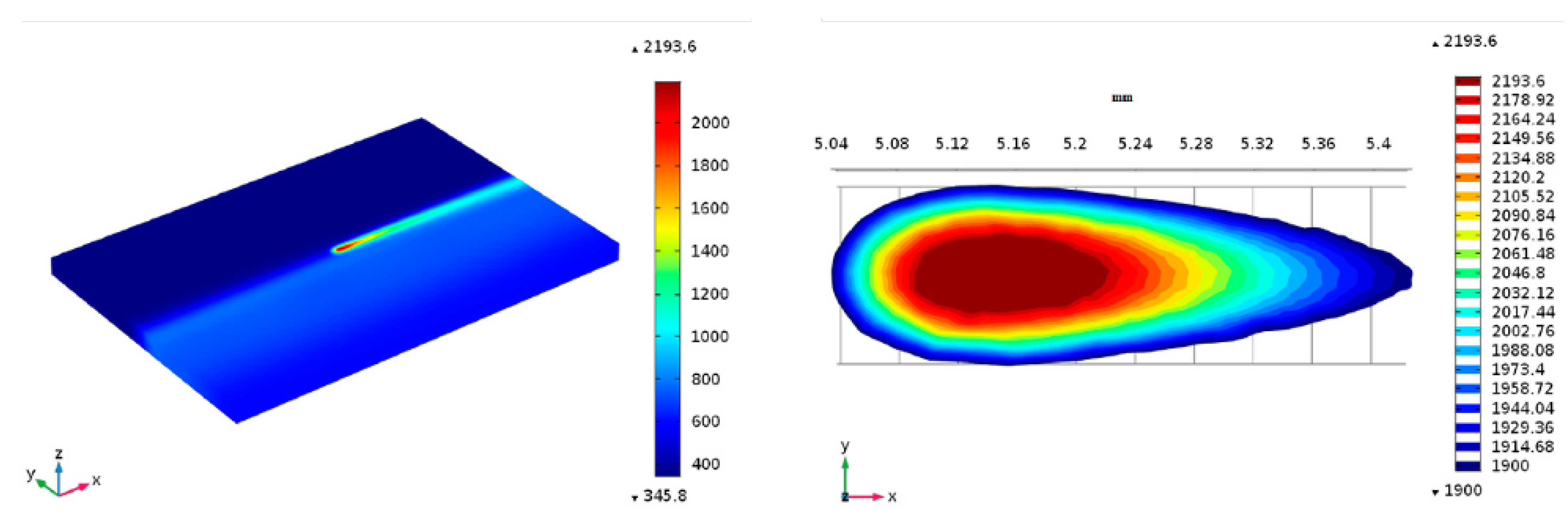
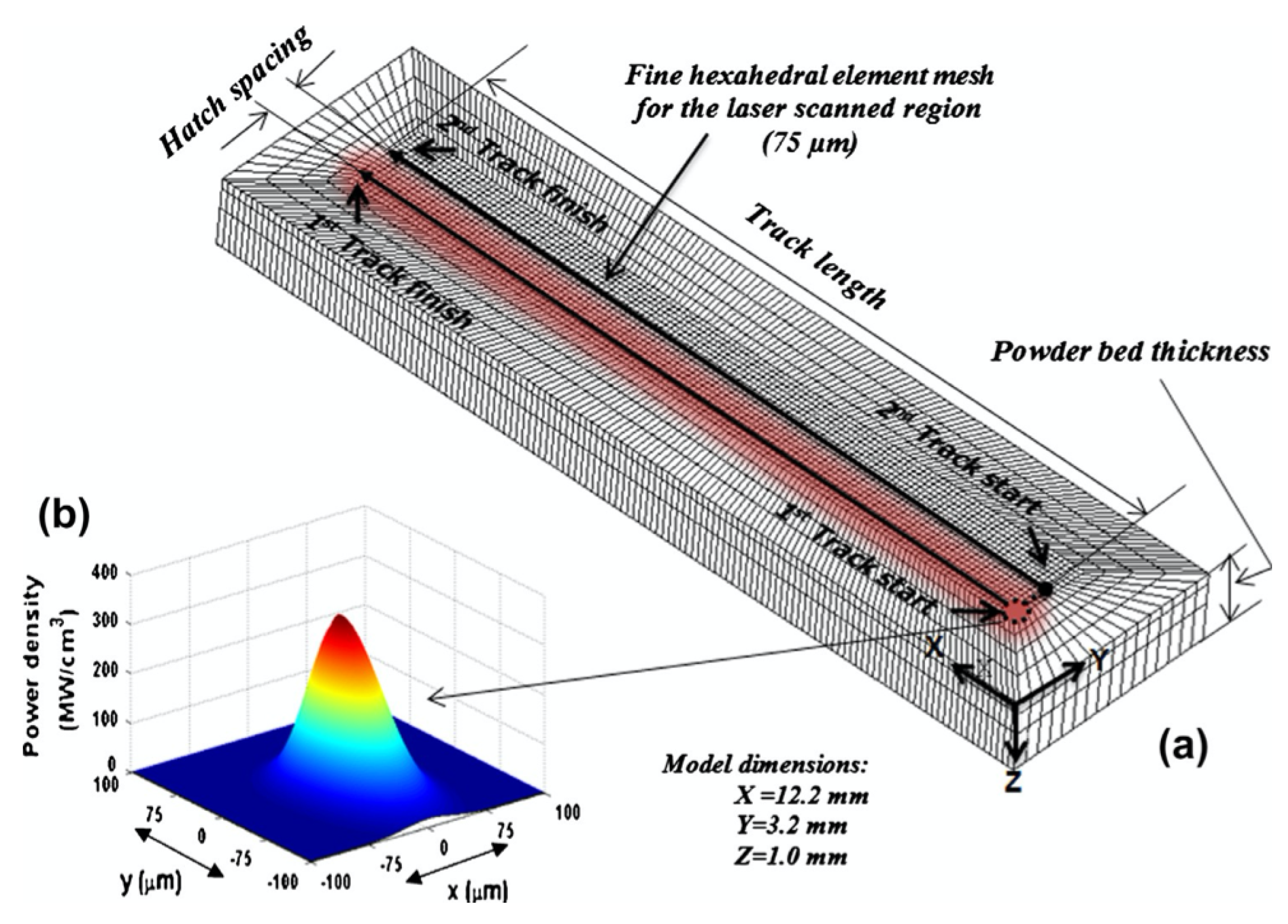
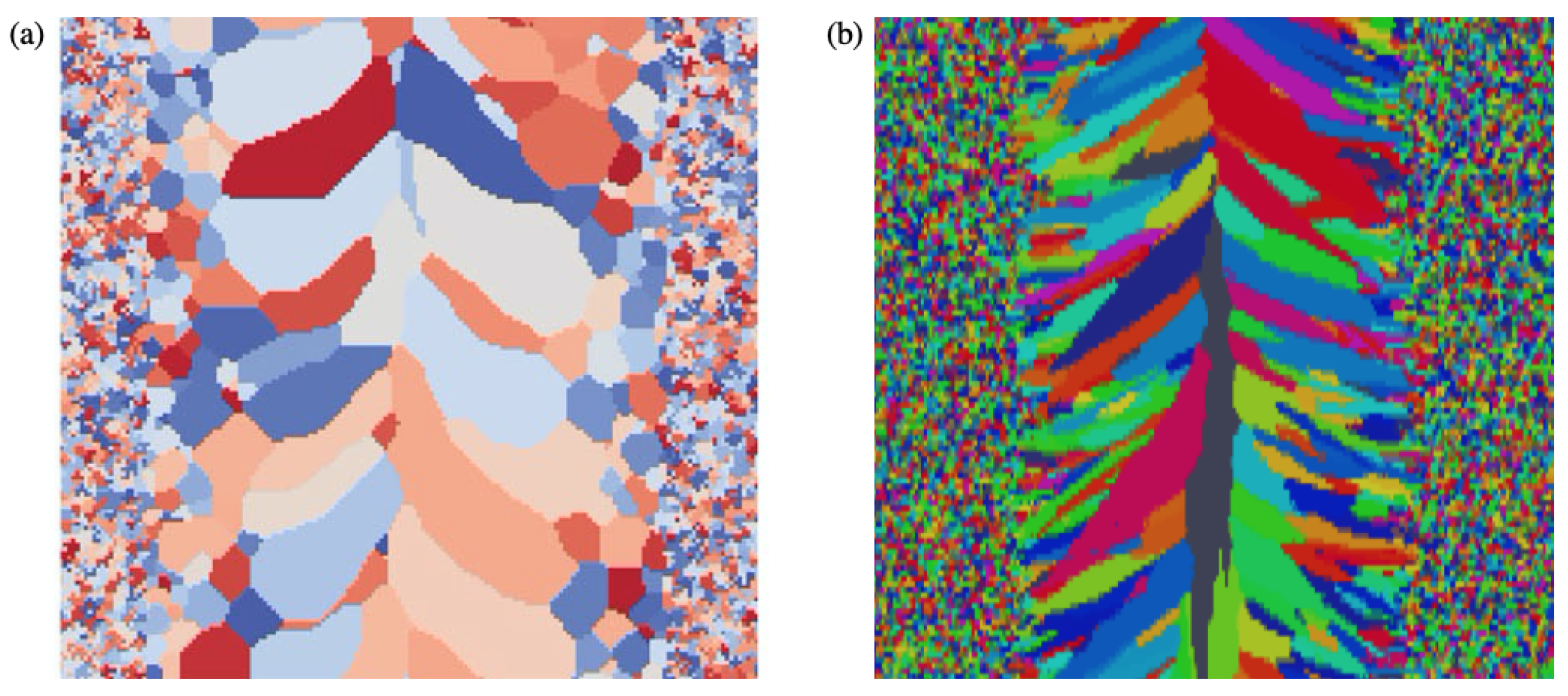
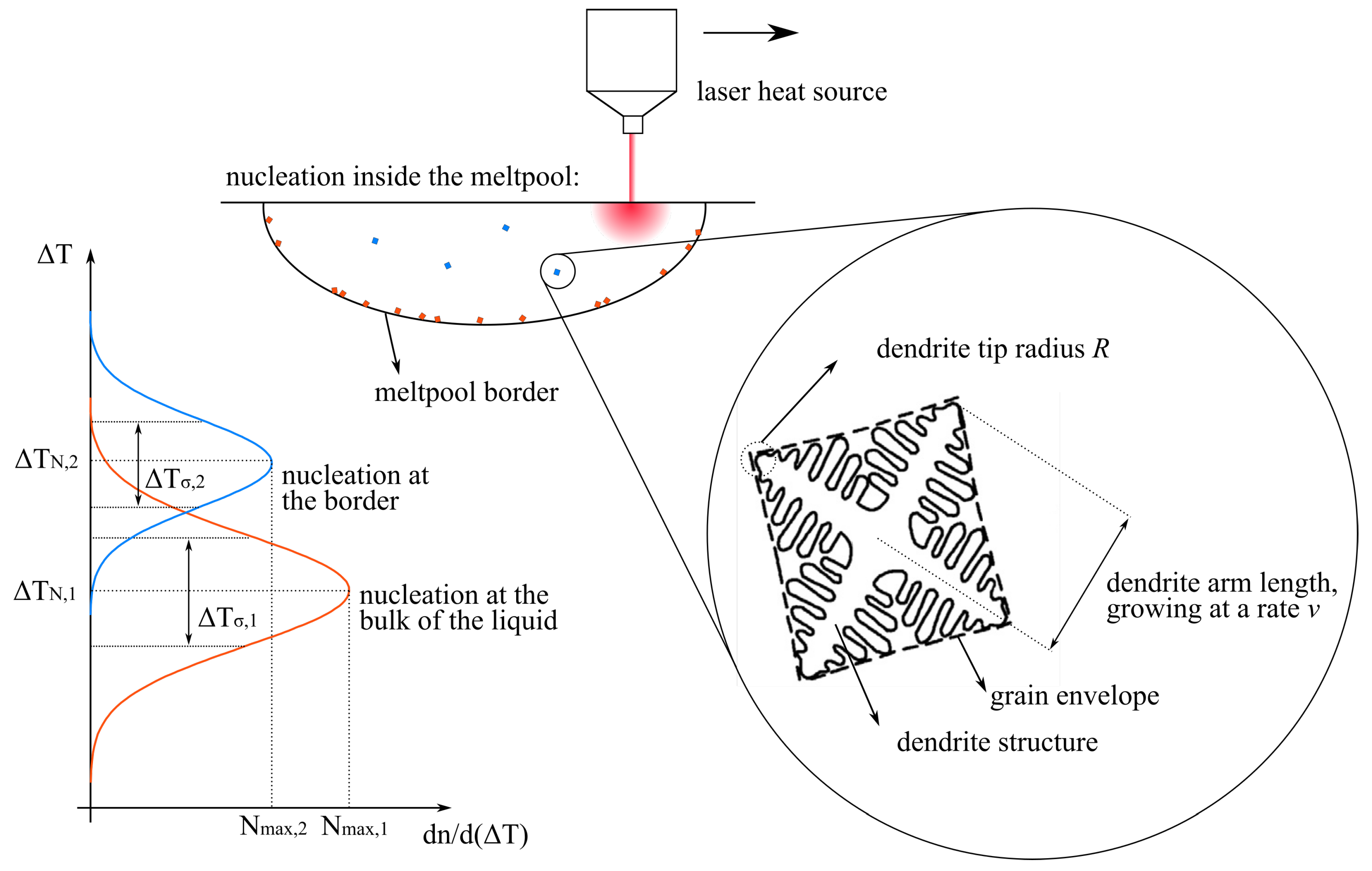
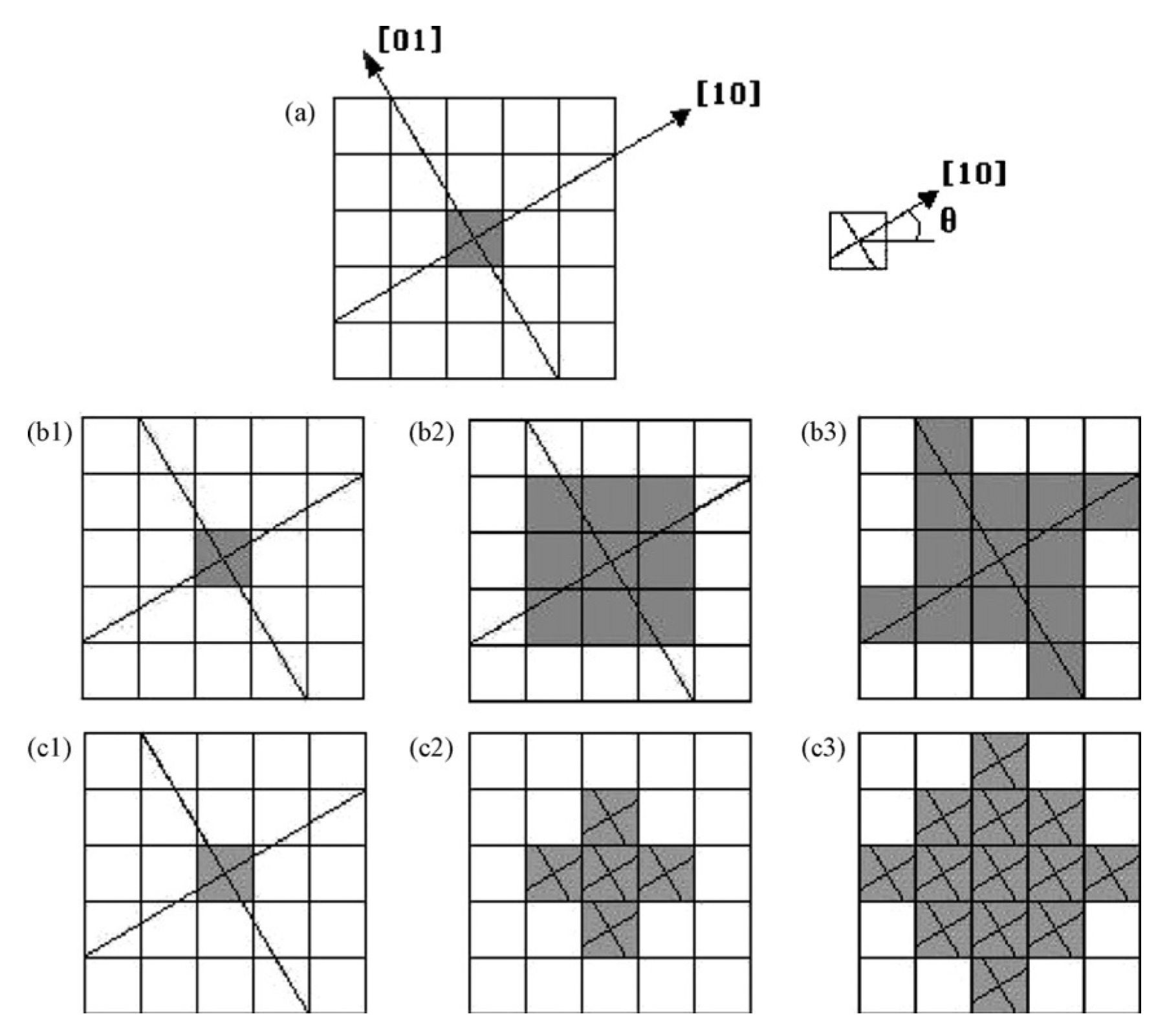
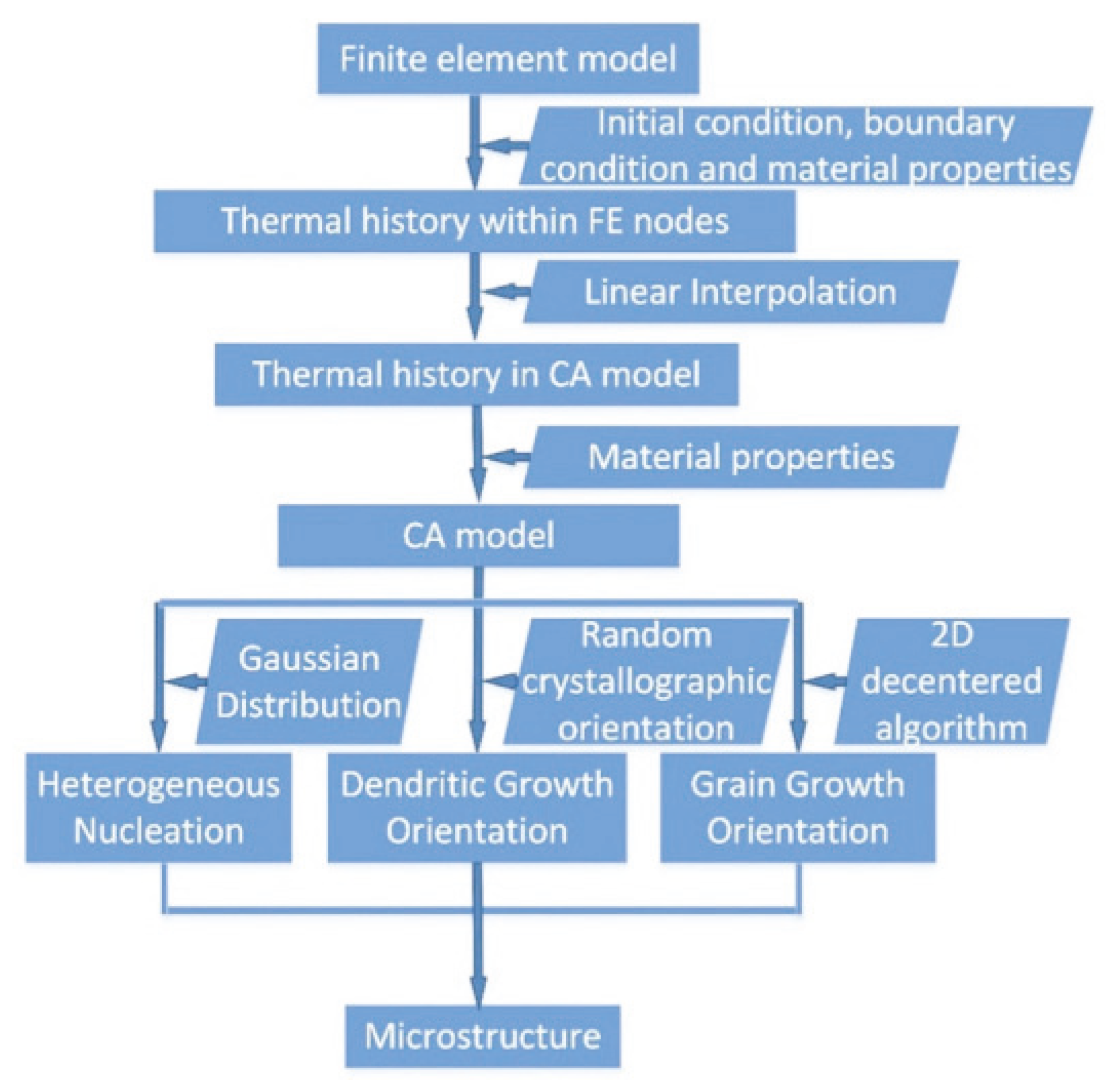
© 2020 by the authors. Licensee MDPI, Basel, Switzerland. This article is an open access article distributed under the terms and conditions of the Creative Commons Attribution (CC BY) license (http://creativecommons.org/licenses/by/4.0/).
Share and Cite
Mede, T.; Kocjan, A.; Paulin, I.; Godec, M. Numerical Mesoscale Modelling of Microstructure Evolution during Selective Laser Melting. Metals 2020, 10, 800. https://doi.org/10.3390/met10060800
Mede T, Kocjan A, Paulin I, Godec M. Numerical Mesoscale Modelling of Microstructure Evolution during Selective Laser Melting. Metals. 2020; 10(6):800. https://doi.org/10.3390/met10060800
Chicago/Turabian StyleMede, Tijan, Andraž Kocjan, Irena Paulin, and Matjaž Godec. 2020. "Numerical Mesoscale Modelling of Microstructure Evolution during Selective Laser Melting" Metals 10, no. 6: 800. https://doi.org/10.3390/met10060800
APA StyleMede, T., Kocjan, A., Paulin, I., & Godec, M. (2020). Numerical Mesoscale Modelling of Microstructure Evolution during Selective Laser Melting. Metals, 10(6), 800. https://doi.org/10.3390/met10060800





